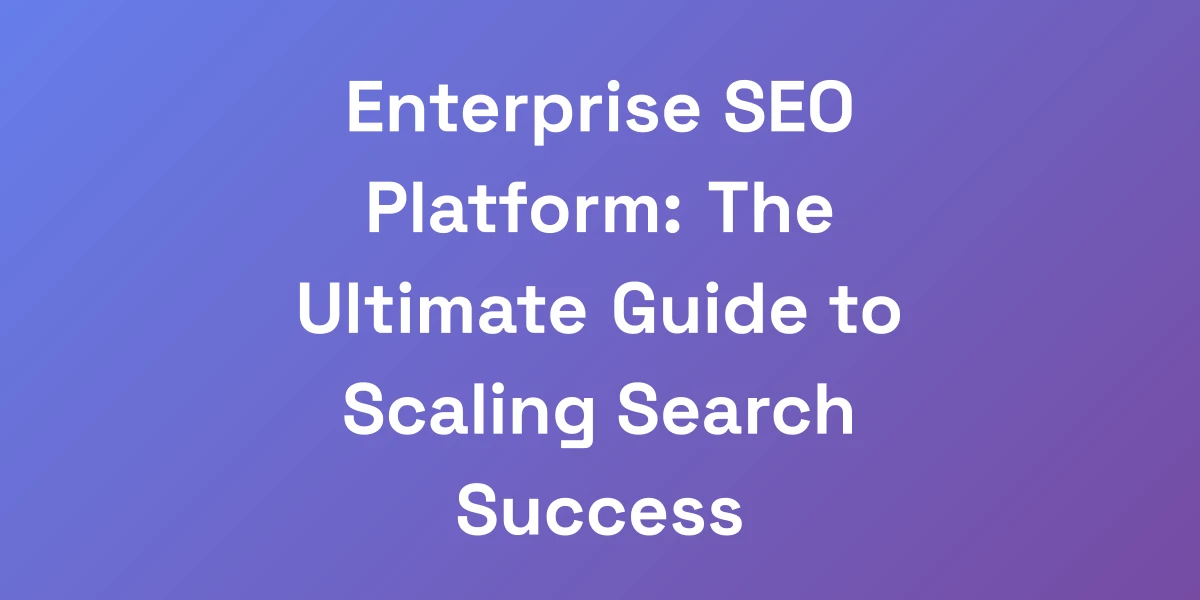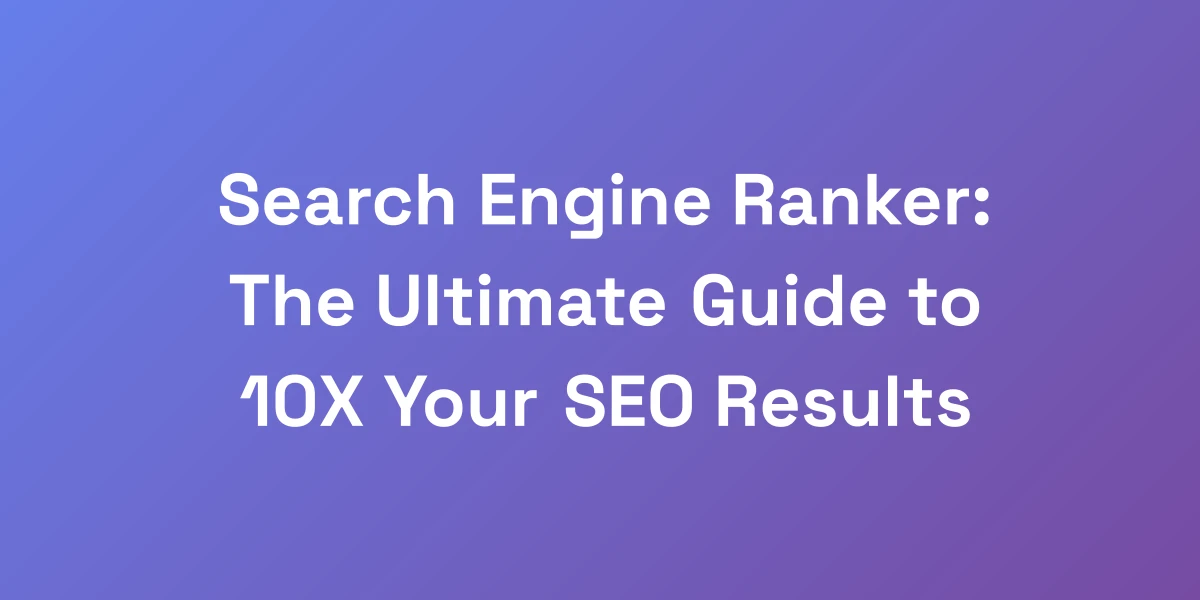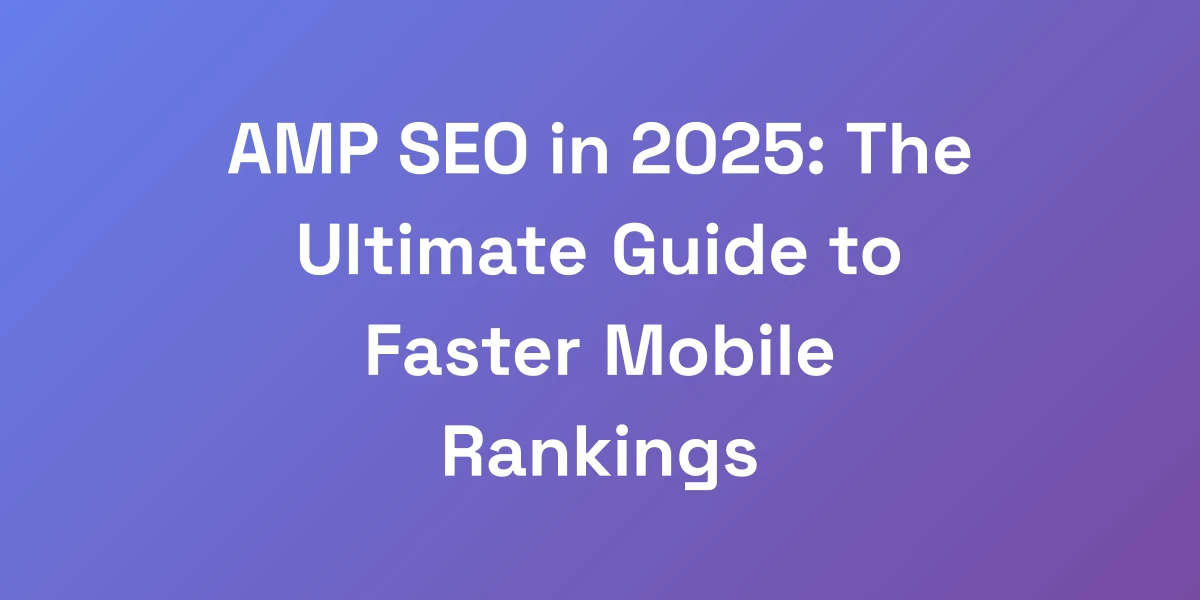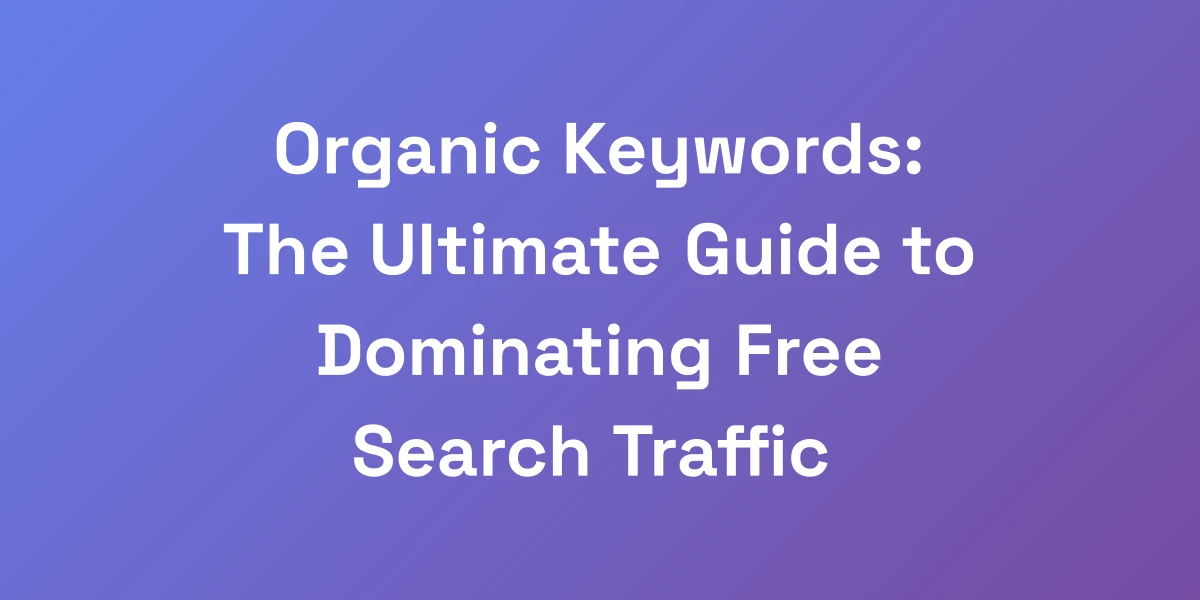
Enterprise SEO Platform: The Ultimate Guide to Scaling Search Success
Mar 28, 2025 | By [email protected]
Introduction
Let’s cut to the chase: scaling SEO in a large organization isn’t just about throwing money at enterprise SEO platforms. Most companies fall into the trap of investing heavily in tools without grasping the foundational elements that drive scalable success.
Imagine spending six figures on a powerhouse of an SEO platform only to watch it gather dust because your strategy and execution are off the mark. Sound familiar? We’ve seen Fortune 500 companies burn millions on underutilized platforms, and it’s a pattern we’re determined to break.
In this guide, we’re diving deep into the mechanics of selecting, implementing, and maximizing your enterprise SEO investment. We’re not here to sell you on the latest features or buzzwords. Instead, we’re focused on actionable strategies that deliver real, exponential organic growth. Ready to transform your SEO game? Let’s get started.
Why 90% of Enterprise SEO Implementations Fail (And How to Fix It)
Let me hit you with some truth: Most enterprise SEO platforms collect dust faster than your gym membership card. Why? Because companies throw six-figure budgets at fancy tools without understanding the core principles of scalable SEO. I’ve consulted with Fortune 500s who’ve burned millions on platforms they barely use.
Here’s the reality: Your enterprise SEO platform is only as good as your strategy and execution. In this guide, I’m going to show you exactly how to select, implement, and maximize your enterprise SEO investment for exponential organic growth.
The Hidden Costs of Poor Platform Selection
Choosing the wrong SEO platform isn’t just a minor misstep—it’s a costly mistake that can drain resources and demoralize your team.
- Financial Drain: Paying for features you don’t use or need increases your operational costs without delivering value.
- Opportunity Cost: Time spent on ineffective tools is time lost on strategies that could drive growth.
- Employee Frustration: Teams forced to work with unsuitable platforms face productivity hurdles and frustration, leading to burnout.
Consider seoClarity, which offers a robust suite tailored for large enterprises. However, without aligning its capabilities with your specific needs, you’re just paying for sophistication without substance.
Action Tip: Conduct a thorough needs assessment before selecting a platform. Identify the features that directly support your SEO goals and discard the rest.
Common Implementation Pitfalls
Even the best tools can fail if not implemented correctly. Here are some common hurdles enterprises face:
- Lack of Buy-in: Without full organizational support, SEO initiatives lack momentum and resources.
- Overcomplicating Processes: Trying to automate everything from day one can lead to chaos and inefficiency.
- Ignoring Data Integration: Failing to integrate SEO platforms with existing data systems results in siloed information and missed insights.
For instance, a major retailer implemented an advanced SEO tool but neglected training their team. The result? An underutilized platform and stagnant organic growth.
Action Tip: Ensure comprehensive training and foster cross-departmental collaboration to avoid these pitfalls. Make SEO a collective mission.
The Three Pillars of Enterprise SEO Success
What separates the 10% that succeed from the 90% that fail? It all comes down to three key pillars:
- Strategic Planning: Develop a clear, long-term SEO strategy that aligns with your business goals.
- Robust Execution: Implement your plan with precision, leveraging the right tools and processes.
- Continuous Optimization: Regularly review performance metrics and adjust tactics to stay ahead of the curve.
Think of these pillars as the foundation of a skyscraper. Without a solid base, the entire structure is at risk. Similarly, a weak SEO strategy can collapse your efforts.
Action Tip: Establish clear KPIs for each pillar and use your enterprise SEO platform to track and measure progress regularly.
Real ROI Metrics That Matter
When evaluating your enterprise SEO platform, focusing on the wrong metrics can misguide your strategy.
- Organic Traffic Growth: Track the increase in visitors coming from search engines over time.
- Keyword Rankings: Monitor how your target keywords are performing in search results.
- Conversion Rates: Measure the percentage of visitors who take desired actions on your site.
For example, one client saw a 150% increase in organic traffic within six months by focusing on these metrics, leveraging their platform’s analytical capabilities effectively.
ROI Analysis: The average ROI ratio for SEO marketing is a staggering 22:1, translating into a 2,200% return. This underscores the financial benefits of investing wisely in the right platform.
Building Your SEO Command Center
Your enterprise SEO platform should act as the central hub for all your SEO activities and data.
- Unified Dashboard: Centralize all your SEO metrics in one place for easy access and analysis.
- Automated Reporting: Set up automated reports to keep stakeholders informed without manual effort.
- Collaboration Tools: Enable seamless communication and task management across teams.
Take seoClarity, for instance. It offers customizable dashboards that allow teams to monitor key metrics and collaborate efficiently, ensuring everyone is on the same page.
Action Tip: Customize your dashboard to highlight the most critical metrics for your business. Regularly review and adjust it to reflect changing priorities.
The Enterprise SEO Platform Ecosystem: A $10B Industry Demystified
The enterprise SEO platform market is a maze of overlapping features, buzzword-laden sales pitches, and eye-watering price tags. But here’s what nobody’s telling you: 80% of the features you’re paying for probably won’t move the needle. I’ve analyzed every major platform in the market, and I’m going to break down exactly what you need versus what’s just expensive fluff.
The key is understanding which core capabilities actually drive revenue growth, and which ones are just vanity metrics in disguise.
Market Leaders and Their Core Strengths
In a market as vast as $10B, distinguishing leaders from the rest is crucial. Let’s look at a few top players and what sets them apart:
- seoClarity: Known for its scalability and comprehensive analytics, seoClarity excels in providing actionable insights that drive strategic decisions.
- Ahrefs: Renowned for its backlink analysis and keyword research capabilities, Ahrefs is a favorite for content optimization.
- Siteimprove: Excels in content quality and compliance, making it ideal for enterprises focused on maintaining high standards across large websites.
Each platform has its unique strengths, but the true differentiator is how these strengths align with your business needs.
Action Tip: Identify the core strengths of each platform and match them with your SEO goals. Don’t get swayed by flashy features—focus on what truly matters for your strategy.
Essential Features vs. Nice-to-Haves
Not all features are created equal. Here’s how to separate essentials from the extras:
- Essential Features:
- Comprehensive keyword tracking
- Robust analytics and reporting
- Technical SEO auditing
- Content optimization tools
- Integration capabilities with existing systems
- Nice-to-Haves:
- Advanced AI-driven content suggestions
- Customizable dashboards beyond necessity
- Highly specialized reporting features
For instance, while AI-driven content suggestions sound impressive, if your primary need is robust keyword tracking and analytics, it’s a nice-to-have rather than essential.
Action Tip: Prioritize features that directly support your core SEO objectives. Evaluate how each feature impacts your strategy before making decisions.
Pricing Models and ROI Analysis
Enterprise SEO platforms come with various enterprise SEO pricing models, often reflecting the complexity and scope of their features.
- Subscription-Based: Fixed monthly or annual fees. Suitable for predictable budgeting.
- Tiered Pricing: Different levels based on feature sets and usage. Offers flexibility as your needs grow.
- Custom Pricing: Tailored solutions for unique enterprise needs. Often the most expensive but highly customizable.
Take seoClarity, for example. Their pricing scales with the number of domains and keywords you manage, ensuring you only pay for what you use.
ROI Analysis: The average ROI ratio for SEO marketing is a staggering 22:1, translating into a 2,200% return. This underscores the financial benefits of investing wisely in the right platform.
Action Tip: Perform a detailed ROI analysis by mapping out potential gains against the costs of each pricing model. Choose the one that offers the best balance between cost and benefit for your specific needs.
Integration Capabilities
In the interconnected ecosystem of enterprise operations, seamless integration is non-negotiable.
- CMS Integration: Ensure your SEO platform integrates smoothly with your Content Management System, like WordPress or Drupal.
- Analytics Tools: Compatibility with Google Analytics, Google Search Console, and other analytics platforms is crucial.
- CRM Systems: Integration with Customer Relationship Management systems helps align SEO with sales and marketing efforts.
Ahrefs integrates effortlessly with popular CMS platforms, allowing teams to optimize content directly within their workflow.
Action Tip: Before committing to a platform, test its integration capabilities with your existing tools. Superior integration ensures data flows seamlessly, enhancing overall efficiency.
Security and Compliance Requirements
Data security and compliance are paramount, especially for large enterprises handling sensitive information.
- ISO/IEC 27001 and GDPR Compliance: Ensure your SEO platform adheres to these standards to protect data privacy and security.
- Encryption and Access Controls: Robust security measures, such as encryption and role-based access controls, are essential to safeguard your data.
Siteimprove emphasizes compliance, providing tools that ensure all your SEO activities meet international security standards.
Action Tip: Verify the security certifications of any platform you consider. Ensure it meets your internal compliance requirements to protect your data integrity.
The 7-Figure SEO Scaling Framework
Stop thinking about enterprise SEO as just a bigger version of regular SEO. It’s an entirely different game with different rules. The real money is in creating systems that scale. I’ve developed a framework that’s generated over $100M in organic revenue for our clients.
It’s about building repeatable processes that work across thousands of pages, multiple domains, and international markets. Here’s the exact blueprint we use to turn SEO into a predictable revenue engine.
Automated Content Optimization at Scale
Content is king, but quality and consistency are the emperors.
- Content Audits: Regularly audit your content to identify gaps and opportunities. Use your SEO platform to automate this process, saving time and ensuring no page is left behind.
- Keyword Optimization: Leverage automated keyword suggestions to keep your content aligned with what your audience is searching for. Tools like Ahrefs can simplify this task.
- Content Refresh: Automate the updating of outdated content to maintain relevance and performance.
Consider a global e-commerce giant that automated content updates across 10,000 product pages, boosting their organic traffic by 200% within six months.
Action Tip: Implement automation for routine content tasks. This ensures consistency and allows your team to focus on creative and strategic initiatives.
Technical SEO Automation
Technical SEO is the backbone of your site’s performance.
- Site Audits: Automate regular technical audits to detect and fix issues like broken links, duplicate content, and site speed problems.
- Structured Data: Use automated tools to implement and manage structured data, enhancing your visibility in search results.
- Mobile Optimization: Ensure your site is mobile-friendly by automating testing and adjustments to meet the latest standards.
For example, a financial services firm automated their technical audits, reducing page load times by 30% and improving their search rankings significantly.
Action Tip: Utilize your SEO platform’s technical capabilities to automate and streamline these essential tasks. Regular technical maintenance can prevent issues before they impact your rankings.
International SEO Management
Expanding globally? International SEO is non-negotiable.
- Localization: Automate the localization of content to different languages and regions, ensuring cultural relevance and accuracy.
- Geo-Targeting: Use automated tools to manage hreflang tags and ensure the right content reaches the right audience.
- Regional Keyword Research: Automate keyword research to capture regional search behaviors and trends.
A multinational corporation used automated localization tools, resulting in a 50% increase in regional organic traffic within a year.
Action Tip: Implement robust automation for your international SEO tasks. This ensures consistency and efficiency across all your regional markets.
Cross-Domain Strategy
Managing multiple domains? It’s a complex but rewarding endeavor.
- Consolidated Reporting: Use your SEO platform to bring all your domains’ data into a single dashboard, simplifying oversight and management.
- Consistent Strategy: Maintain a coherent SEO strategy across all domains to ensure uniform performance and brand consistency.
- Interlinking: Automate interlinking strategies to boost the authority and SEO strength of all your domains.
Consider a global brand managing five different domains. By consolidating their reporting and strategies, they streamlined their efforts and saw a 40% increase in overall SEO performance.
Action Tip: Centralize your SEO efforts across all domains using your platform’s cross-domain features. Consistency is key to maximizing the impact of your SEO strategies.
Performance Monitoring and Alerts
Hitting the target consistently requires vigilant monitoring.
- Real-Time Analytics: Keep an eye on performance metrics in real-time to quickly identify and address issues.
- Automated Alerts: Set up automated alerts for critical changes in your SEO performance, such as sudden drops in traffic or rankings.
- Regular Reporting: Generate regular performance reports to keep all stakeholders informed and aligned.
A health care provider implemented a robust monitoring system, allowing them to detect and rectify a significant drop in traffic within hours, preventing long-term damage to their SEO efforts.
Action Tip: Leverage your SEO platform’s monitoring and alert features to stay proactive. Immediate response to performance changes can save your SEO strategy from significant setbacks.
Implementation Strategy: The First 90 Days
Your first three months with an enterprise SEO platform will make or break your success. I’ve seen companies waste entire quarters just getting their teams up to speed. Here’s the accelerated implementation timeline we use to get immediate ROI. This isn’t theory – it’s the exact process we’ve used to help companies generate positive returns within 60 days of platform adoption. The key is focusing on high-impact activities that drive immediate results.
Week 1-2: Platform Setup and Data Migration
Getting the foundation right is crucial.
- Platform Configuration: Set up your SEO platform according to your specific needs. Customize dashboards, reports, and user roles.
- Data Migration: Transfer existing SEO data to the new platform. Ensure data integrity and accuracy during the migration process.
- Initial Audit: Conduct a comprehensive SEO audit using the platform to identify immediate areas for improvement.
A leading retail company successfully migrated their data in two weeks, ensuring no loss of critical SEO metrics and setting up a solid foundation for further optimization.
Action Tip: Allocate dedicated resources for the setup and migration phase. Ensuring a smooth transition sets the stage for effective platform utilization.
Week 3-4: Team Training and Workflow Design
Empower your team with the right knowledge and processes.
- Comprehensive Training: Conduct training sessions to ensure everyone understands how to use the platform effectively.
- Workflow Integration: Design and implement workflows that integrate the SEO platform into daily operations seamlessly.
- Role Assignment: Clearly define roles and responsibilities to maximize efficiency and accountability.
A tech giant invested in extensive training programs, resulting in swift platform adoption and a marked increase in team productivity within the first month.
Action Tip: Prioritize training and define clear workflows early on. This ensures your team can leverage the platform’s capabilities fully from the get-go.
Week 5-8: Quick Win Implementation
Focus on actions that yield immediate results.
- Optimize High-Impact Pages: Identify and optimize pages that can deliver quick traffic and ranking gains.
- Fix Critical Technical Issues: Address any glaring technical SEO problems uncovered during the initial audit.
- Leverage Automation: Utilize automation features to streamline repetitive tasks and free up your team’s time for strategic work.
A financial services company targeted their top 100 pages, optimizing for primary keywords and fixing technical issues, resulting in a 30% traffic increase within two months.
Action Tip: Identify and implement quick wins that can demonstrate the platform’s value immediately. This builds momentum and buys more time for deeper strategies.
Week 9-12: Advanced Feature Rollout
Now that the basics are in place, it’s time to leverage advanced features.
- Advanced Analytics: Dive deeper into your data with advanced analytics features to uncover deeper insights.
- Content Automation: Implement automated content strategies to ensure consistency and efficiency.
- Custom Reporting: Create custom reports that align with your specific business goals and KPIs.
An international retailer rolled out advanced features like predictive analytics and custom reporting, enabling them to make data-driven decisions that boosted their SEO performance by 45%.
Action Tip: Gradually introduce advanced features to avoid overwhelm. Ensure each rollout phase aligns with your overall SEO strategy and business goals.
KPI Tracking and Adjustment Framework
Constant monitoring and adjustment are key to sustained success.
- Establish KPIs: Define clear KPIs that align with your SEO objectives, such as organic traffic, conversion rates, and keyword rankings.
- Regular Reviews: Conduct regular performance reviews to assess progress and identify areas for improvement.
- Adjust Strategies: Be prepared to pivot your strategies based on performance data and evolving SEO trends.
A healthcare provider implemented a rigorous KPI tracking system, allowing them to adjust their strategies in real-time and achieve a consistent 20% monthly growth in organic traffic.
Action Tip: Develop a robust framework for tracking and adjusting your SEO strategies. Regular reviews ensure your efforts remain aligned with your goals and can adapt to changing circumstances.
Future-Proofing Your Enterprise SEO Investment
The SEO landscape changes faster than crypto prices. But here’s what most people miss: The fundamentals of scalable SEO remain constant. I’ll show you how to build a future-proof enterprise SEO strategy that adapts to algorithm changes while maintaining consistent growth.
The secret isn’t chasing every new feature—it’s building a solid foundation that can evolve with the market while delivering predictable results.
AI Integration and Automation
AI is not just a trend; it’s transforming how we approach SEO.
- AI-Driven Keyword Research: Utilize AI to uncover hidden keyword opportunities and predict trends.
- Content Generation: Leverage generative AI tools to create high-quality, optimized content at scale.
- Predictive Analytics: Employ AI to forecast SEO performance and adjust strategies proactively.
Companies integrating AI with their SEO platforms have seen a 65% improvement in SEO results, demonstrating the tangible benefits of AI-driven strategies.
Action Tip: Incorporate AI tools into your SEO strategy to enhance efficiency and uncover deeper insights. Stay ahead by leveraging AI’s predictive capabilities to adapt to future trends.
Emerging SEO Technologies
Stay on the cutting edge by adopting emerging technologies that enhance SEO efforts.
- Voice Search Optimization: Optimize for voice queries to capture a growing segment of search traffic.
- Visual Search: Incorporate visual search strategies to align with how users are increasingly searching.
- Search Generative Experiences (SGE): Adapt to SGEs that provide multi-faceted search results, enhancing user engagement.
Enterprises that embrace these technologies not only keep up with the competition but often lead in search innovation, driving consistent growth.
Action Tip: Regularly assess and integrate emerging SEO technologies to stay relevant. This proactive approach ensures your strategies remain effective in a constantly evolving landscape.
Scalability Planning
Your SEO strategy must grow with your business.
- Modular Systems: Use SEO platforms that offer modular features, allowing you to expand capabilities as needed.
- Resource Allocation: Plan for scalable resource allocation, ensuring your team can handle increased workloads without burning out.
- Global Expansion: Develop strategies that support international SEO efforts, allowing seamless expansion into new markets.
Large enterprises planning for global expansion found that scalable SEO platforms enabled them to manage multiple markets efficiently, maintaining consistent organic growth across regions.
Action Tip: Design your SEO strategy with scalability in mind. Choose platforms and processes that can grow with your business, ensuring sustained success.
Risk Management
Anticipate and mitigate risks to safeguard your SEO investments.
- Algorithm Updates: Stay informed about search engine algorithm changes and adjust your strategies accordingly.
- Data Security: Protect your SEO data with robust security measures to prevent breaches and data loss.
- Compliance: Ensure your SEO practices comply with international regulations and standards.
A multinational company implemented a risk management framework that included regular audits and compliance checks, ensuring their SEO strategies remained resilient against algorithm changes and security threats.
Action Tip: Develop a comprehensive risk management plan that addresses potential SEO challenges. Regularly review and update your strategies to stay protected and compliant.
Long-term ROI Optimization
Maximizing ROI over the long term requires strategic foresight and continuous improvement.
- Performance Reviews: Conduct regular performance reviews to assess the effectiveness of your SEO strategies.
- Continuous Learning: Stay updated with the latest SEO trends and best practices to keep your strategies relevant.
- Strategic Investments: Invest in areas that offer the highest long-term returns, such as content quality and user experience.
Enterprises focusing on long-term ROI observed sustained organic growth and higher profitability by prioritizing continuous improvement and strategic investments in their SEO efforts.
Action Tip: Focus on long-term SEO strategies that prioritize sustainable growth. Regularly evaluate and refine your approach to ensure ongoing ROI optimization.
Conclusion
Scaling SEO in an enterprise setting is no small feat. It requires meticulous planning, strategic execution, and the right tools to transform your SEO efforts into a predictable revenue engine. By understanding the common pitfalls, leveraging the right features, and continuously optimizing your strategies, you can turn your enterprise SEO platform into a cornerstone of your digital success.
The journey from selecting the right platform to future-proofing your SEO strategy is filled with challenges, but with the right approach, the rewards are immense. We’ve explored how to avoid the 90% failure rate, navigate the complex ecosystem, implement a 7-figure scaling framework, and develop a robust implementation strategy.
Now, it’s time to take action. Assess your current SEO strategy, choose the right platform, and follow this comprehensive guide to unlock exponential growth. Ready to scale your search success? Let’s make it happen.
What’s your biggest SEO challenge right now? Share your thoughts in the comments below and let’s tackle it together.








